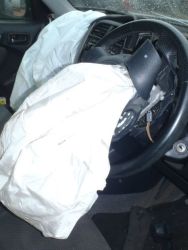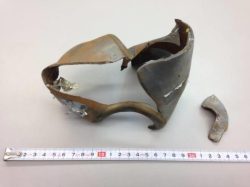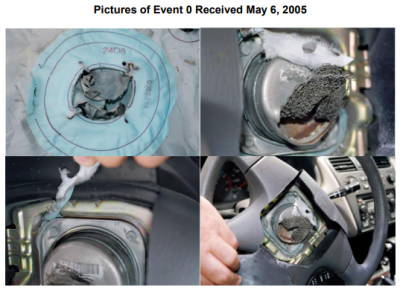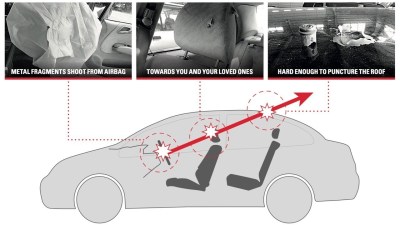Takata Corporation has become well known as a lesson in product safety, thanks to their deadly airbags which were installed in cars worldwide. Despite filing for bankruptcy in 2017, their shadow lingers on as the biggest product recall in history continues to grow ever larger. Over time, the story grows deeper, as investigators find new causes for concern and deaths continue to mount.
In late 2019, another Takata recall was announced — one which caused fresh worry among industry officials familiar with the case. Up to this point, the defective parts produced by Takata were the models based on ammonium nitrate propellants, a chemical that other manufacturers had deemed too dangerous to use. However, there have been reports of other models using different chemistries having fatally injuring motorists, raising the question of whether any Takata airbag could be considered safe.
Problems, Plural

After years of research, both internally and by outside investigators, the problem seemed settled. Takata had chosen to use a propellant that became unstable over time, thus leading to overpressure events which could destroy the metal airbag casing, causing injuries and fatalities to drivers and passengers. It was believed that this affected only the phase-stabilised ammonium nitrate (PSAN) airbag inflators. This chemistry was only used by Takata, as other manufacturers had deemed it too dangerous for practical use.
In 2019, everything changed with the first recalls for Takata’s NADI 5-AT inflators. NADI stands for Non-Azide Driver Inflators, which use a tetrazole propellant, widely considered safe when used properly. Takata NADI airbags in cars produced between 1996 and 2001 are reported to have taken two lives in Australia, This is on top of the existing 24 deaths and 300 injuries worldwide caused by Takata’s PSAN inflators.

According to Takata’s submission to the National Highway Traffic Safety Administration, the issue is caused by a defective foil seal, which fails to prevent moisture ingress into the airbag casing. Moisture ingress can have several negative effects on inflator performance. It may cause slow deployment of the airbag, reducing its effectiveness at restraining passengers in the event of a crash. Alternatively, through repeated cycles of moisture ingress and drying or freezing, the propellant may mechanically break down, increasing its surface area.This leads to an increased rate of reaction, creating the overpressure events that shatter casings, spraying passengers with deadly shrapnel.

I reached out to John Keller, a former Takata engineer from 1998-2001, for comment on these recent developments. John undertook studies into the performance of airbag products at the time, collecting data on a variety of models. According to John, “Propellant surface area is critical. If there’s too much propellant surface area, relative to the vent area, during combustion the inflator housing can fracture […] It’s important regardless of the propellant formulation […] The increase in propellant surface area from the broken propellant could cause the inflator to rupture.”
In the cases of deaths and injuries caused by Takata airbags, the primary cause has been due to metal fragments ejected by the airbag. In practice, this has led minor accidents involving airbag deployments to become casualty events. Drivers are being instructed to avoid driving their vehicles in some cases, with automakers doing mobile inspections or towing vehicles to dealerships.
Getting To The Root Cause
As pictured in the video above, faulty inflators deploy with violent results. Understanding the cause behind this is key to solving the problem. With recalls now affecting multiple different Takata airbag chemistries, it is no longer realistic to place the blame solely at the door of ammonium nitrate. Instead, it hints at a broader issue in design and manufacture. In the case of the NADI inflators, the problem is an imperfect moisture seal. With regards to the PSAN inflators, similarly humidity and moisture are blamed.

In November 2015, The NHTSA gave Takata until December 31st, 2019 to prove that PSAN inflators featuring a dessicant were safe to use. Thus far, the federal agency has not commented definitively on the issue, which would lead to a recall of yet further vehicles. According to Keller, “That remedy is not fundamentally sound. It’s an illusion of a remedy that may persuade some people, but not anyone who truly understands Takata’s inflator defects. Eventually any desiccant will saturate, once that happens, moisture goes into propellant.”
The common thread here is the effect of moisture ingress on propellant stability. With multiple airbag types now affected, it’s clear that the broader issue at play is one of poor inflator design, not simply the selection of the wrong propellant chemistry. This should raise alarm bells for other airbag manufacturers, who can no longer consider themselves safe for having avoided the use of ammonium nitrate in their designs. Instead, it goes to show that rigorous attention must be paid to the long-term stability of the propellant charge. Failure to control this issue can lead to tragic results.
Given the long lifetime of the average automobile, the public have reason to expect airbags to remain safe over many decades of use. Any protection method that comes with a time limit, such as a dessicant, seems likely to cause more problems down the road. As more and more cars with airbags reach old age, there remains the possibility that more airbags will suffer dangerous failures. Thus far, other manufacturers have largely avoided major issues with degradation on a timescale of multiple decades, but whether these devices can remain safe over 40 years, 50 years, or further, remains an open question. At these timescales, this only affects a tiny fraction of motorists driving vintage vehicles, but one that the community will have to face nonethelesss.
Moving Forward
The timescale involved confounds efforts to solve the problem. As the latest NADI recalls cover vehicles of a greater age, it becomes difficult for automakers to remedy the issue. BMW estimate it will take between 14 and 22 months to develop and produce replacement parts. Along with Toyota, they are the only manufacturers intending to do so. The business case for redesigning parts for a small fleet of cars up to 25 years old is a poor one, due to the huge engineering and logistical expensive involved. Other companies are instead exploring buyback programs to compensate consumers for their vehicles that are no longer safe to drive.
Airbags are not a part that can readily be treated as a consumable, due to the dangers involved in their installation and handling. With these constraints in place, research will be required to ensure airbags can withstand such extended environmental exposure without becoming dangerous to vehicle occupants. Most manufacturers have thus far succeeded in this task; time will tell if they can keep up the good work.
The fact that multiple branches of Takata’s technology has proven fatal suggests a deeper problem at the company, rather than one fateful poor decision. Manufacturing defects were allowed to flow out to customer vehicles, leading to the loss of several lives and countless further injuries, some of which are permanently life-altering. Against that background are the devastating economic consequences, which have affected the livelihoods of many who worked for Takata or related companies. It’s clear that rigorous change is required from automakers and suppliers to ensure such a disaster is not allowed to happen again.















Takata: the “gift” that keeps on giving.
Airbags always had a risk of killing you instead of saving you, but I’d say the risk is quite a bit higher now that they’re firing buckshot at your face point-blank.
Frontal airbags are useless when wearing a 3-point seatbelt but it seemingly was easier to mandate installing costly and deadly bombs in cars rather than make people wear their seatbelts.
Side airbags also become useless when wearing a 5-point seatbelt but at least they’re useful for 3-point seatbelts that don’t restrain you sideways.
The best part is in a lot of places you’re not legally allowed to upgrade to / use a 5-point seatbelt seat for road use, especially if the side airbag is integrated to the OEM car seat then you’re stuck with it.
People who removed the passenger seat to deliver stacks of pizza can’t do that anymore ( *depending on legislature wording).
In the meantime rally cars with 5-point seats and roll cages are doing a dozen rolls and smashing into a tree at 150KPH and the crew is well enough to climb out while swearing and cursing for being out of the race.
So we got this weird situation where I can ride my bike on a 70KPH road (with ppl driving 90) and that’s all fine and dandy but we can’t legally upgrade our cars for road use to be much safer than stock.
By bike I mean plain pedal bicycle doing a casual 10 – 20 KPH, so a 70-80KPH delta between me and that 18 wheeler that can suck me under its trailer.
But even a motorcycle shows the ridiculous gap in safety requirements.
Are you sure about that? Do you have a link to literature?
I always thought that the combination of both is the best option…
That’s exactly what I told the service manager the other week when I got my third airbag replaced under this recall.
It’s almost as if producing non-serviceable assemblies is a bad idea. On the water, life saving pyrotechnics, i.e. flares, have a mandated 42 month expiry. Though boaters say “They’re probably still good for a decade”… probably isn’t much comfort if you’re relying on a single example.
For airbags as you are betting on it firing correctly when you need it. For expired flares, you could have a spare that happens to work to save the day. It doesn’t literally blow up in your face either like faulty airbags.
I wouldn’t be so categorical about flares not blowing up in your face. Google for firework-accidents and you will find lots of cases of fireworks erupting not according to expectations and directions.
I’m wondering if we’re expecting too much out of these. How long a life is too long for the fundamental technology, especially given this isn’t exactly a shelf life. Maybe we need to start replacing them at 5 years on schedule.
Yes, that’s what I was getting at above, serviceable. Little cartridge deally, swap it out every 5 years.
It’s an explosive charge, all sorts of liability and safety risks with them, as well as worrying about people using them as a source for bombs. Currently they’re only shipped as part of a car, and hard to get to. A lot less risk than having boxes full of them travelling to mechanics around the world.
That’s not correct, my Saab was recalled for a faulty air bag long after Saab had gone out of business, I brought it to a Chevy dealer for the recalll, they had many boxes of airbags on hand to satisfy the recall.
My SAABs are pre the mandated recall but then it raises the question of them been over 20 years old are they deteriorating and likely to cause a problem.
I’m starting to feel I should remove all the air bags and be done with it.
replace the whole airbag unit then.
But that may not be possible unless a compatible unit is made. I’ve not looked into this so am totally unaware of the hardware involved. Might have to pull a car apart and have a look
Replace the steering wheel. With a non airbag unit if necessary, I guess.
I’m working in a company that makes airbags and seat-belts. You cannot change the inflator alone. For the driver front airbag (steering wheel) everything is neatly tucked-up in the DAB (the thing you push on to honk – usually). The bag is neatly folded by robots in a specific pattern, after the inflator has been attached to the bag. Opening that up to change the inflator makes the whole airbag assembly unusable.
Also transporting airbags and seat-belts (who also have pyro, even some buckles do) is very costly and in some countries it needs police escort. That cost is doubled by the fact that the old airbags, dismounted from the car will have to be transported to a decommissioning site. Making inflators as spare parts that can be ordered every 5 years would make this component so expensive, no one would change it.
Anyway, i wouldn’t trust a mechanic working on an airbag, except plugging in a poka-yoke connector. This is done to make sure that the airbag malfunction will be detected by the Safety Computer – not/incorrect plugging is detected on the firing line. Even if the inflator could be changed, there isn’t enough poka-yoke in the world to make sure it’s being done correctly in the field and not in a controlled environment (that’s why we use robots and multiple human and computer visual checks).
PS: as any component in a car, airbag it is guaranteed for 15 years.
That’s gonna be expensive and cause people to clamor old non-airbag shitboxes.
That last picture is very unnerving. Involuntary Russian roulette with a safety mechanism…
The nice thing is, that most safety mechanisms you’re at least playing Russian Roulette with 999 empty chambers and one bullet.
Takata backwards: ATAK AT … driver?
Hmmm…this worries me, I have two cars with 34 year old first-generation airbags. May be worse than nothing.
Or not, your mechanic may have stolen them years ago and replaced them with a resistor.
Wow, that really happens? We should have a massive inquiry, hunt them down, leave no stone unturned and thank them for their foresightedness :-D
excellent
if those are that old, they most likely use azides to generate gas
I’m completely safe, none of my cars have airbags… oh wait
But you need to leave that claymore mine in place until we can get the parts for the recall because saaaafteeeey!
Not every airbag malfunctions and a possibly working airbag is safer than no airbag at all during a collision. Basic looooogiiiiic.
“However, there have been reports of other models using different chemistries having fatally injuring motorists,”
Is it just me or would read better as “having fatally injured” or just “fatally injuring” without the “having”?
Oh and if I offended you and your going to “take me for a ride” please don’t do it in a car with a Takata air bag.
Yes, yes I realize the grammar mistakes I made in that previous message.
* having made to occur the fatalistic injurification implemented upon the person of motoristically inclined parties
Hey, it’s my favourite dinosaur, Thesaurus Rex!
I had the Takata inflators replaced on my old Honda as a result of a recall. Later, the replaced Takata inflators were recalled, and I had to have the replacements replaced. How do I know if the ones now in the care are safe?
it isn’t the propellant so much as it is that the leaky inflators was being used despite that they should have been destroyed.
the inflators had a faulty weld where air and moisture would leak into them making the propellant unstable.
due to how much money they stand to lose by destroying the defective inflators they used them anyways.
Why can’t airbags use a source of compressed gas? The charge is just there to create gas to inflate the bag, so store the gas compressed in something like a CO2 cartridge.
*facepalm* They do. The whole issue that is being discussed is about the gas stored inside the cartridge.
no, they use a solid fuel rocket ^H^H firecracker ^H^H combustion-gas generator. pressurized cold-gas doesn’t have the velocity-pressure needed
That also has problems over long time scales. Permeation of the CO2 through the cylinder etc, also the heavier the gas the less the permeation, but tendency to be useless in winter.
Space is probably one of the biggest factors. They use a small explosive charge or propellant to generate the ‘gas’ that inflates the airbag. The propellant takes up little space and generates a large volume of expanding gas as it burns. To do the same thing with a cylinder of compressed gas would add complexity, weight, and a compressed gas cylinder, and those have to be re-certified every few years. They’d also experience a pressure drop in colder weather, inflating less efficiently, or completely, and they’d likely be prone to having their safety discs burst in a hot car during the summer months from heating up and over pressurizing the cylinder.
Now that’s an idea, why don’t they have overpressure safety blowouts in, so if solid propellant does go bad it blows out it’s buttplug or something.
That should not be a problem. At winter the speed limits are already lower. Also fast and reckless driving happens much more likely At summer. There could also be a warning text displayed on the dashboard when cold. Or a simple heating element could be installed on the gas cylinder.
You need a precise amount of inflation in a very small amount of time yet be compact and stable for years in a harsh vibration environment like in a car. I’m not absolutely sure, but a CO2 cartridge may simply not be fast enough.
Having worked at an airbag inflator manufacturer (not Takata) they do! Usually it’s not CO2. The core problem as mentioned previously, is the size to gas expansion ratio. Solid propellants go from a very compact size to a much larger volume of gas. So we would use inert gas like a nitrogen mix at 9ksi or so and have that for a rollover curtain. The rollover curtain is a small airbag, but because you can enclose it all along the top of the window.
Likewise on the passenger side, there’s a lot more space for an inflator… not enough for cold gas, but you can do a burning gas. We would use a mix of hydrogen/oxygen and burn that inside the inflator to produce enough gas. H2’s also definitely a permeability problem for sure.
Driver’s side it’s very very hard to get away from a solid propellant. There’s just not enough space inside a steering wheel to house that much gas at a reasonable pressure.
In the longer version of the explosion video it appears that what is happening is that some of the propellant is actually not combusting and is instead bypassed, where it is then forced out to block the vents. Once the vents are blocked the pressure spikes and that drives the rate of reaction as pressure increases the temperatures.
The normal effect of moisture on ammonium nitrate is to make it far less explosive, which is why the US Military looked into how long IEDs based on it were likely to remain dangerous when exposed to the environment.
The instability isn’t that ammonium nitrate becomes hyper explosive; if it was then there would be explosions all over the US as it is used in mass quantities in farms. The instability is that it becomes useless and won’t burn properly, though if used in the correctly designed pipe-bomb, there can be secondary effects, unrelated to combustion rate, that will result in detonation.
They need to design the capsule with an intentional over-pressure relief.
So wait, does this include multi-stage airbags?
I know some German cars have two-stage airbags, where one charge just pops it out and slightly inflate the bag, and the other fully fills it.
Skoda auto (“schade Wagen”) has the opposite problems – the airbags don’t inflate. Or actually, they do, but sometimes it takes 15 seconds a sometimes just the packed pillow jumps out of the compartment and does not inflate at all. Now, what is more on the safe side? ;)
Huh, I thought they’d been owned by VW since airbags were much of a thing, so would have same safety components.
the Fabia 2 had a huuuge capacitor in the airbag unit because the “efficiently routed” battery cables kept getting shorted before the airbag was fired and redoing those would’ve been too expensive…
I wonder if that’s a problem in the Chrysler cloud cars in front quarter impacts with the battery being mounted in front of the fenderwell.
Some years back, a friend went to a bone yard to get a steering wheel for his ’76 Chevy Nova. He complained to me that someone previously removed the airbag from it.
I didn’t have the heart to tell him.
I’m still overly amused at azides being the *safe* option.
they are widely used for primers in small arms ammo and they do just fine…one major problem is the toxicity.
Put the steering wheel on the passenger side. Driver is now safe.
The UK, Oz, Japan, NZ, would like to share something with you…
They all have the wheel on the drivers side, ask them.
The car in the first picture (Australia) is not a BMW.
The recalled airbags are no joke. I’m a BMW enthusiast. I bought a 2003 E46 3 series under the recall last year for parts. My friend and I got curious about the airbags under recall. We carefully removed all the bags. I live in the northeast in a very rural area so no neighbors. We set off the drivers airbag with a car battery and 300ft of wire to the airbag. After it detonated there was about a 10-15 circle of parts, mostly the casing. I have no doubt if that was contained in the small space of the drivers seat of an e46 you’d be severely injured or killed. No joke at all. We decided after the drivers bag to leave the rest alone.
Terrifying!
Any pictures/more details? Would love to hear more – lewinday@hackaday.com
I’ll see if I can dig up photos and send them your way. We observed a debris ring roughly 10-15 feet in diameter. Obviously there was parts everywhere but around where it went off that’s where stuff was roughly. Like I said not good and it changed my mind on how I handle those affected bags in anymore parts cars I buy.
It’s pretty sad we are having also safety stupidity stuck down our throats. Pretty sad that some posting here don’t get it at all and like the government telling them what to do all the time.
I have a couple older vehicles because that’s all I can afford. Sadly, I’m told I’m not allowed to remove an air bag because of safety, so I’m being told that I’m too stupid as a consumer to evaluate my own personal risks.
I have an 1997 F350 crew cab, full length bed, 4WD, 5 speed manual transmission with a Power-Stroke Diesel engine, that was intended for the logging industry in Washington State. This was the last year of the decent looking trucks made by Ford and it has NO airbags. I bought the truck new in January of 1998 and I have put all of the 204,000 plus miles on it myself. I drive it with confidence knowing that the Claymore that is NOT in my steering wheel is NOT there to kill me in an accident.
I have always worn a seat belt in every car I ever owned. Even my first car was 1956 Ford station wagon, with lap belts. Of all the people I know that have been in car accidents, only the ones that wore a seat belt faired the best in accidents. Even an airbag will not keep you from being ejected from the vehicle and risk being crushed by the very vehicle they were ejected from.
I think I will just buckle up and keep my old truck.